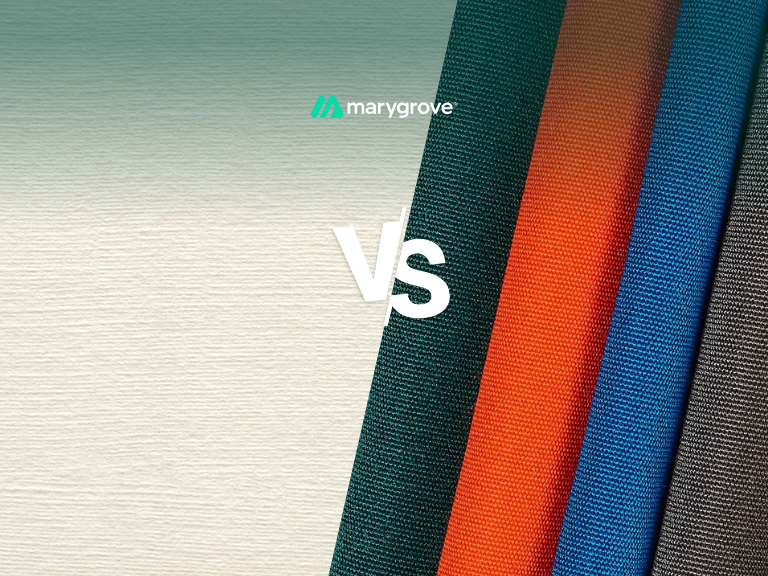Acrylic awnings outperform canvas in durability, weather resistance, and maintenance, while canvas wins on cost, eco-friendliness, and customizability. The better choice depends on your climate, lifestyle, and whether long-term performance or flexibility matters more.
Canvas vs Acrylic Awnings: Which One Truly Fits Your Outdoor Space?
Choosing the right awning fabric directly affects how well your patio, deck, or backyard setup performs, especially when it comes to sun, rain, and year-round comfort.
If you’re torn between canvas and acrylic, here’s what you need to know:
- Acrylic offers better durability and holds color longer under UV.
- Canvas is easier to install and can be painted or customized.
- Acrylic is more resistant to water, mold, and daily wear.
- Canvas is budget-friendly and made from biodegradable materials.
- Acrylic works better with smart tech and needs less upkeep.
- Canvas fits vintage aesthetics and suits seasonal or short-term use.
Canvas offers flexibility and charm, while acrylic delivers durability and ease. Each transforms your outdoor space differently, your choice depends on style, features, and lifestyle fit.
Stick around, and you’ll see exactly how to match the right awning to your lifestyle.
Canvas vs Acrylic Awnings: What They Are and Why the Difference Matters
Choosing the right awning fabric affects more than just appearance, it influences comfort, upkeep, and how well your outdoor space handles sun, rain, and daily use.
Before we compare performance, let’s look at what each fabric brings to the table.
What is a Canvas Awning?

Canvas awnings are made from natural fibers like cotton or hemp. They have a soft, classic look that fits well with traditional or historic homes.
They’re breathable and budget-friendly, which makes them popular with DIYers and homeowners looking for a quick solution.
But canvas comes with more upkeep. It absorbs moisture, fades under UV, and can grow mildew if stored or used wet.
It also traps heat and may stretch or sag over time, especially in harsh climates.
What Is an Acrylic Awning?
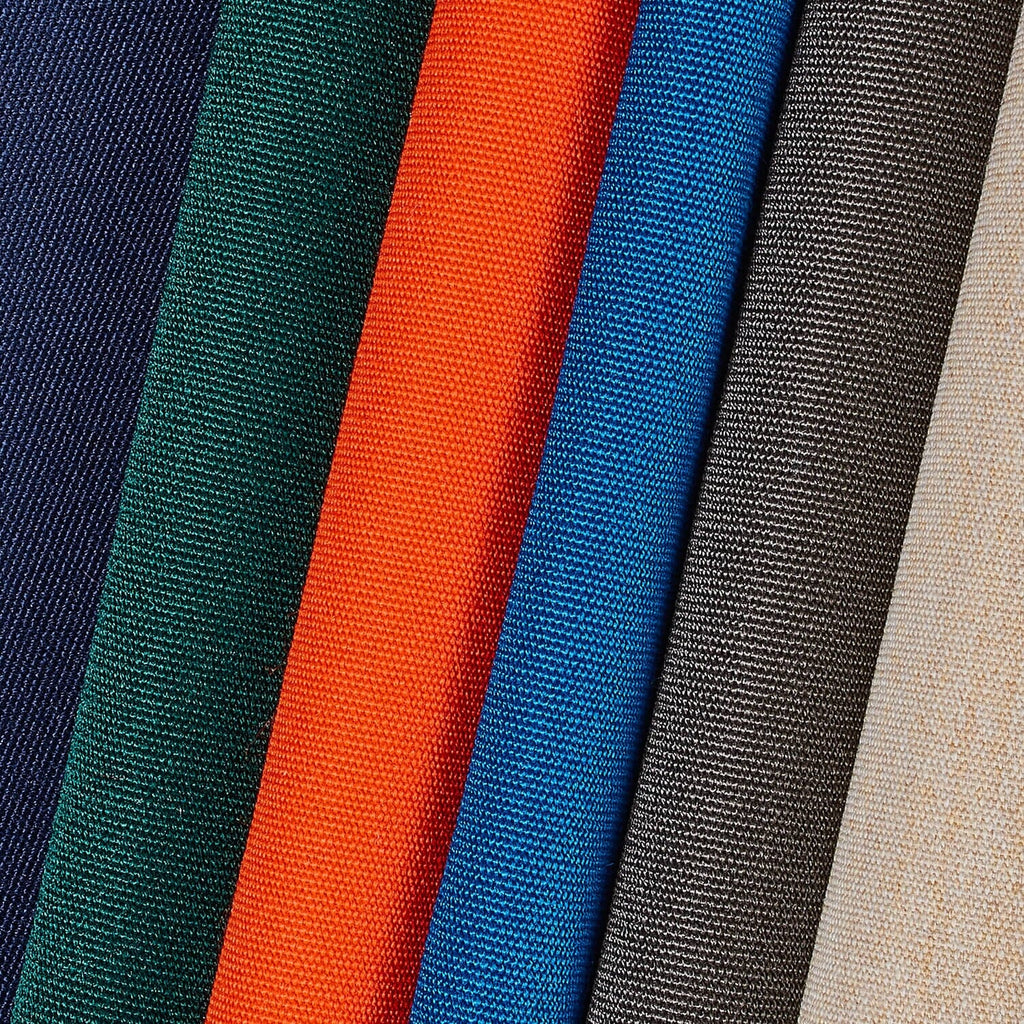
Acrylic awnings use synthetic threads built for the outdoors. They resist fading, repel water, and dry fast, making them ideal for wet or sunny climates.
Acrylic also keeps its shape better and needs less maintenance over the years.
Modern acrylic options come in sleek, long-lasting colors and often integrate with smart systems.
They’re less customizable but offer greater durability and comfort under the sun.
The Bottom Line: Canvas and acrylic offer different benefits. To choose wisely, it’s worth seeing how they stack up side by side across the features that matter most. Ready to compare? Let’s break it down.
Canvas vs Acrylic Awnings: A Head-to-Head Comparison Across 8 Essential Categories
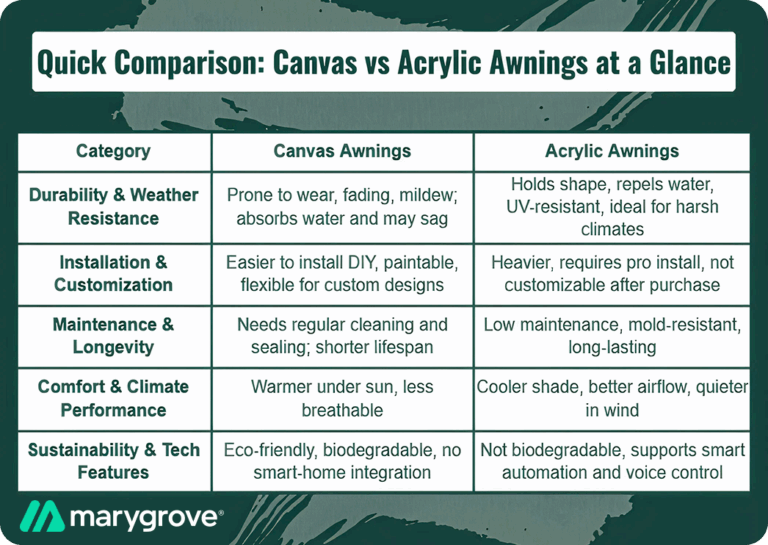
From poolside retreats to patio dining spaces, your awning’s fabric is what separates a good experience from a great one.
Below is a true side-by-side breakdown of how canvas and acrylic compare, clear, honest, and based on real performance.
1. Durability in the Real World
Awnings are exposed to everything, sun, wind, shifting temps, and daily use. The right fabric should not just survive the elements but keep its form and finish for years.
- Canvas: Tends to wear out faster. It can stretch or wrinkle when exposed to moisture and often needs sealing to prevent fading.
- Acrylic: Holds its shape and color well, even after seasons of sun and rain. Its synthetic weave is designed to handle daily exposure without breaking down.
- Winner: Acrylic. It simply holds up better long term without the need for constant upkeep.
2. Installation Ease and Flexibility
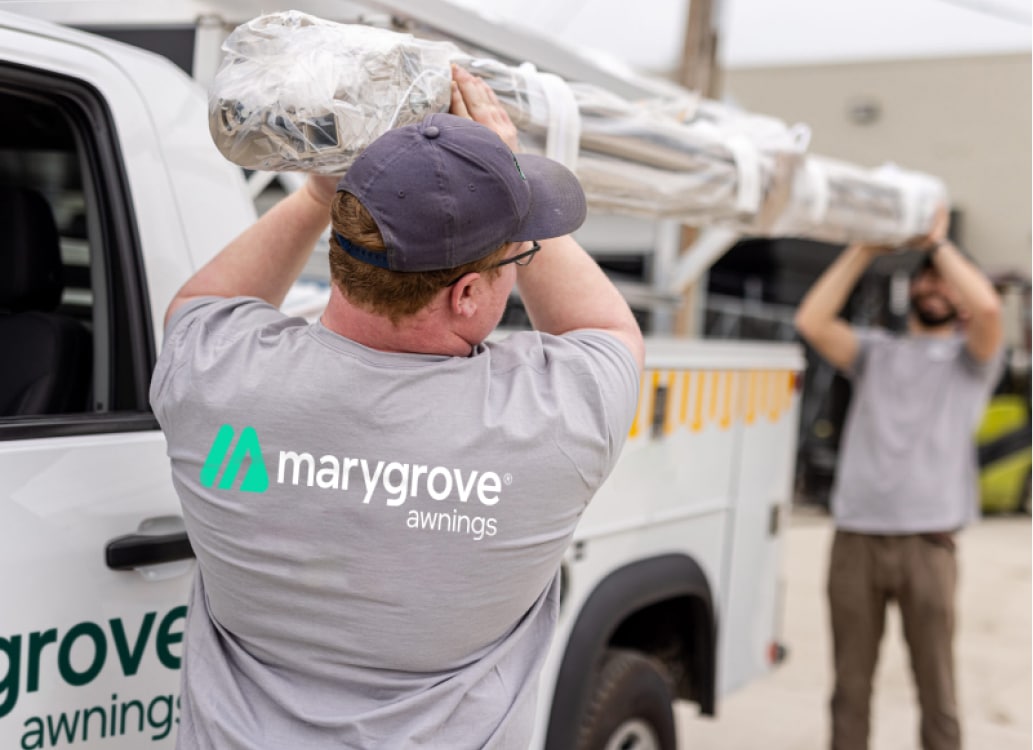
Some awnings are weekend projects. Others are better left to the pros. Installation depends on the fabric’s weight, stretch, and how forgiving it is during setup.
- Canvas: Lighter and easier to work with for DIYers. It can be mounted without heavy tools, though care is needed to avoid stretching.
- Acrylic: Heavier and less forgiving if not tensioned properly. Works best with professional installation to ensure a tight, lasting fit.
- Winner: Canvas. Ideal for straightforward installs or temporary setups, especially where professional support isn’t available.
3. Weather Resistance You Can Count On

From sudden downpours to steamy summer humidity, a weather-resistant awning protects everything underneath, your outdoor furniture, your guests, your peace of mind.
- Canvas: Absorbs water, which can lead to sagging and mildew, especially when left out in rainy or damp conditions.
- Acrylic: Repels water and wicks away moisture quickly. Ideal for humid or rainy climates where drying time matters.
- Winner: Acrylic. It offers more reliable protection against the elements.
4. Customization and Paintability
If you enjoy DIY projects or like refreshing your outdoor look with the seasons, the ability to customize fabric might matter more than you think.
- Canvas: Can be painted or sealed with outdoor fabric treatments. Offers more flexibility for personalizing color, style, or UV protection.
- Acrylic: Comes pre-colored and treated. It holds its color well but isn’t paintable or modifiable after manufacturing.
- Winner: Canvas. Great for homeowners who want creative control or seasonal updates to their awning design.
5. Fabric Breathability and Heat Build-Up
An awning is meant to cool your space, not trap heat. Breathability and shade performance directly impact how comfortable it feels underneath.
- Canvas: Tends to trap more heat, especially in darker colors. In humid conditions, it can also feel heavier and warmer to sit beneath.
- Acrylic: Allows for better airflow and reflects more heat away from the surface. This keeps the area below noticeably cooler during hot afternoons.
- Winner: Acrylic. For spaces like poolside lounges or sun-drenched decks, it offers a more comfortable shade experience.
6. Maintenance and Upkeep Reality Check
You want to enjoy your outdoor space, not spend weekends scrubbing and resealing the awning above it. Fabric care plays a bigger role than most expect.
- Canvas: Requires regular brushing, spot cleaning, and seasonal resealing to prevent mildew and UV damage. Often traps pollen and holds heat.
- Acrylic: Easier to maintain. It resists dirt and mold, rarely needs sealing, and typically only requires a rinse to stay clean.
- Winner: Acrylic. Lower maintenance means more time enjoying the space beneath it.
7. Smart Awning Compatibility
Today’s awnings do more than provide shade, they can respond to wind, rain, or a voice command. Smart compatibility is becoming a game-changer for homeowners who want convenience and control.
- Canvas: Not compatible with smart tech. While you can install a motorized mechanism, canvas doesn’t integrate with app controls or automation features.
- Acrylic: Often used in smart retractable systems. Supports voice control, weather sensors, and app-based automation for retracting or extending during specific conditions.
- Note: If smart features are a top priority, polyester tends to outperform both in terms of integration and responsiveness.
- Winner: Acrylic. It’s the clear choice out of the two for someone seeking smart functionality.
8. Eco-Friendliness and Biodegradability
With sustainability top of mind for many homeowners, the environmental impact of your awning fabric is worth considering, especially for long-term outdoor use.
- Canvas: Made from natural fibers like cotton or hemp. It’s biodegradable and has a lower environmental footprint when produced responsibly.
- Acrylic: Synthetic, non-biodegradable, and more resource-intensive to manufacture. However, its longer lifespan can offset the need for frequent replacements.
- Winner: Canvas. A greener option for those prioritizing natural materials and end-of-life disposal.
Both fabrics bring different strengths to the table depending on your priorities. But to make a truly confident decision, it helps to see where each one thrives in real-life use.
Helpful Resource → Replacing Retractable Awning Fabric: Steps, Tips & Maintenance
The Real-World Case for Canvas vs Acrylic Awnings
Both canvas and acrylic have distinct strengths depending on how you plan to use your awning and what kind of maintenance, climate, or customization you’re comfortable with.
Here’s a closer look at what each option offers in terms of pros, cons, and where each one truly shines.
1. The Case for Canvas Awnings: Pros, Cons & Best Use Scenarios

Canvas awnings offer a familiar look and approachable price point. But like any fabric, they come with their own trade-offs that matter depending on how and where you’ll use them.
Pros of Canvas Awnings
- Lower upfront cost
- Easy to install for DIYers
- Paintable and customizable
- Natural, soft aesthetic
- Eco-friendly material
Cons of Canvas Awnings
- Needs frequent cleaning
- Prone to mildew if stored wet
- Fades quickly in sun
- Louder in wind
- Lacks smart features
Canvas Is Ideal For: Canvas awnings make sense for budget-conscious homeowners, especially those who enjoy hands-on projects or live in dry, mild climates.
They’re a solid fit for historic homes, seasonal setups, or anyone looking for a natural, eco-friendly material with flexible design options.
2. The Case for Acrylic Awnings: Pros, Cons & Best Use Scenarios

Acrylic awnings are built for performance, especially in climates where weather and wear are constant factors.
They tend to be lower maintenance, with better longevity, but they come at a higher starting cost.
Pros of Acrylic Awnings
- Superior durability and color retention
- Excellent weather and mold resistance
- Quiet and cool under sunlight
- Smart-home ready
- Sleek, modern design
Cons of Acrylic Awnings
- Higher initial investment
- Heavier and harder to install
- Not biodegradable
- Cannot be painted or modified
- Less DIY-friendly
Acrylic Is Ideal For: Acrylic awnings are best for homeowners who want long-term performance with minimal upkeep.
They’re ideal in humid or rainy climates, modern builds, or tech-integrated spaces where automation and all-season comfort are priorities.
Bottom Line: Both canvas and acrylic bring clear strengths to the table, it all depends on your climate, priorities, and how hands-on you want to be.
The key is choosing the fabric that aligns with how you plan to enjoy your outdoor space.
Why the Right Awning Does More Than Just Provide Shade
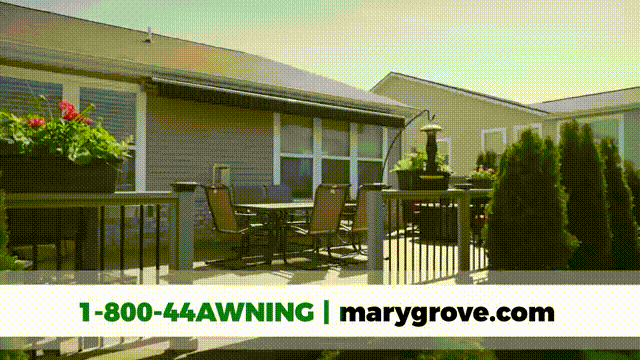
Whether you prefer the timeless charm of canvas or the durable performance of acrylic, the true value of an awning lies in how effortlessly it enhances outdoor living.
A well-placed awning turns any patio into a shaded lounge, shields your furniture from the elements, and gives you more hours to enjoy fresh air, whether it’s brunch on the deck or quiet evenings by the pool.
And for homeowners exploring smarter features, added longevity, or advanced weather resistance, modern fabrics like high-grade polyester (used in select premium systems) offer a noticeable step up in reliability and integration, without sacrificing style.
Marygrove awnings are crafted using high-performance polyester fabric, a material known for its durability, weather resistance, and smart-home compatibility.
If you’re looking for lasting, top-quality awnings built for real-world use, contact us today for a free consultation and quote.
You can even preview a Marygrove awning on your own home using our augmented reality feature, see it in your space before making a decision.
The right awning doesn’t just cover, it transforms.
